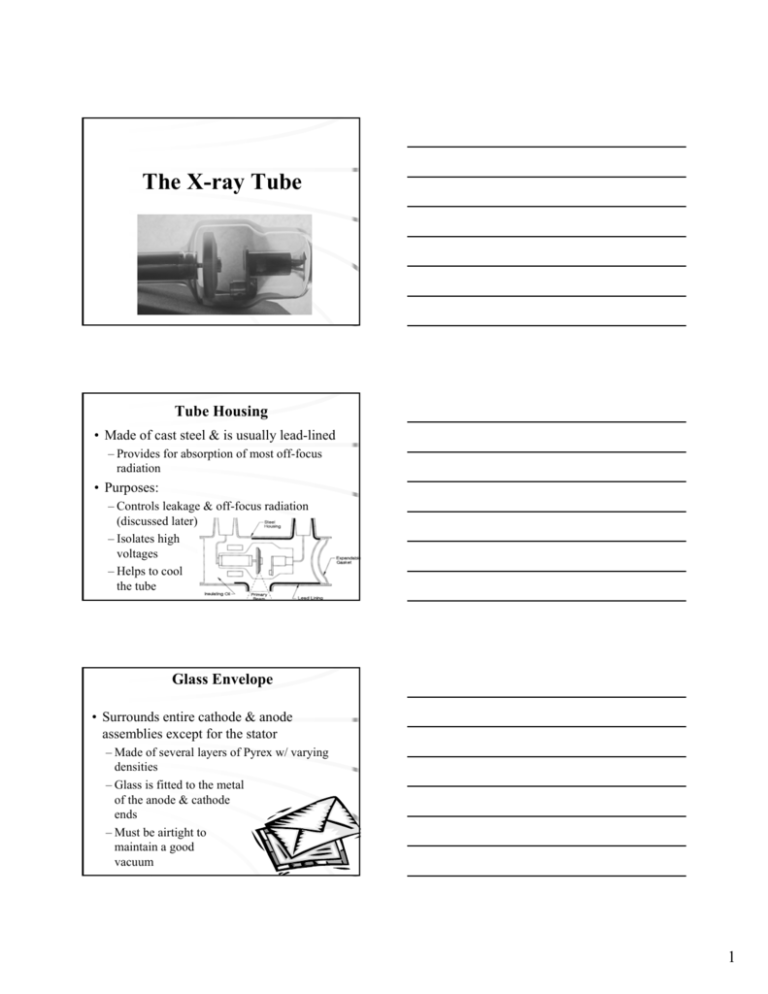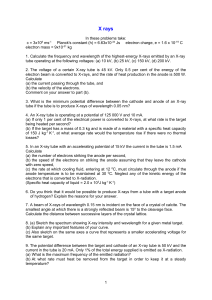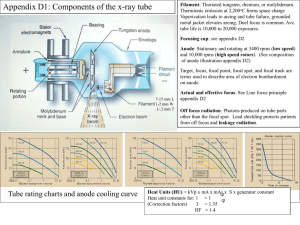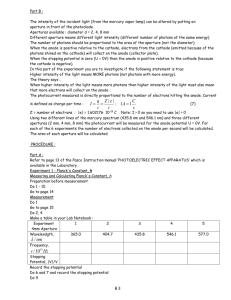The X-ray Tube
advertisement

The X-ray Tube Tube Housing • Made of cast steel & is usually lead-lined – Provides for absorption of most off-focus radiation • Purposes: – Controls leakage & off-focus radiation (discussed later) – Isolates high voltages – Helps to cool the tube Glass Envelope • Surrounds entire cathode & anode assemblies except for the stator – Made of several layers of Pyrex w/ varying densities – Glass is fitted to the metal of the anode & cathode ends – Must be airtight to maintain a good vacuum 1 Glass Envelope • A target window is constructed in the glass envelope to allow less scatter & attenuation of the photons – In most tubes - simply a thinner “cut” of glass – In mammography - a special metallic beryllium window prevents attenuation of lower energy photons Cathode • The cathode is the negative end of the x-ray tube. – Made up of the filament(s) and a focusing cup. Filament • Most x-ray tubes have a dual filament cathode assembly - also known as dual focus – The two filaments sit parallel to each other in the focusing cup & share a common ground wire. – Most filament coils are 7-15mm long , 1-2mm wide, 0.1-0.2mm thick 2 Filament • Filaments must be able to: – Boil off electrons (thermionic emission) – Withstand great amounts of heat • Filament materials – Tungsten - most widely used material • High boiling point (3,370° C) • It is difficult to vaporize – Rhenium (3,170° C) – Molybdenum (2,620° C) Filament • Vaporization occurs over time – When the particles vaporize (turn into a gaseous form), they solidify on the glass of the x-ray tube, called sun-burning or sun-tanning of tube. • Reduce the x-ray output of the tube • destroy the vacuum integrity of the tube, leads to arcing and ultimately tube failure • Thorium (a radioactive metallic element) is added to the filament material to make the tube last longer. Focusing Cup • The focusing cup helps control electron cloud – The electrons repel each other & want to spread out. The focusing cup forces the electrons to form a small stream as they move toward the target material – Made of nickel – Has a low negative charge 3 Grid-Controlled Focusing Cups Some x-ray procedures require exposures be taken at quick intervals. • Grid-controlled focusing cups have a variable charge applied to the focusing cup that acts as an exposure switch – When the tube is activated, the charge increases & decreases rapidly – Short bursts of electrons flowing to the target. Grid-Controlled Focusing Cups • May be found in: – – – – portable capacitor discharge units digital subtraction angiography digital radiography Cineradiography Anode The Anode is the part of the x-ray tube where accelerated electrons move to after kV is applied to the tube. • Two types: – Stationary anode (old type) - just a tungsten button imbedded in copper bar. – Rotating anode consists of a molybdenum disk(target) rotated by an induction motor. 4 Rotating Anode Assembly This is a diagram of a rotating anode without & with the tube. Rotating Anode Stator and Rotor Consists of two main parts: • Stator – Rests just outside of the glass tube – Made up of a series of electromagnets equally spaced around the neck of the tube • Designed to energize opposing pairs, in sequence, so that they induce the rotation of the rotor. • Rotor – Located within the glass tube – Made up of copper bars & soft iron around a molybdenum shaft ***Mutual Induction*** Rotating Anode Stator and Rotor • When the rotor is rotating at the desired level, the x-ray exposure may be completed. • Most revolve at 3400 revolutions per minute (rpm) minimum. • By rotating the anode we spread the generated heat over a larger surface area allowing greater technique loads. 5 Anode Target Characteristics • Anode target - the point on the anode where the electrons strike • Tungsten – rhenium alloy is the most common material and is plated onto the surface of the molybdenum disk • Tungsten has: – High atomic number (74) – High thermal conductivity level – High melting point • Rhenium added to increase thermal capacity and tensile strength The Line-Focus Principle • Actual focal spot - the area of the target material being bombarded by electrons from the filament. • Effective focal spot - the imaginary geometric line that can be drawn based on the actual focal spot size vs. the angle of the anode. • Best described by the angle of the anode – the smaller the angle of the anode, the smaller the effective focal spot size (any angle <450 results in the effective FS being smaller than the actual FS) – 120 target angle most common because it is the minimum that will cover a 14x17 at 40” The Line-Focus Principle cont. 6 The Anode Heel Effect • Caused by the angle of the anode vs. the intensity of the electrons striking it. • X-rays exiting the target on the anode side have to traverse the “heel” of the anode – Photons directed toward the cathode end do not have to travel through as much of the anode because of the angle of the target so more make it out – Those directed toward the anode end must travel through more material so more are absorbed – Results in the beam being of lower intensity on the anode side. The Anode Heel Effect • As much as 20% more photons at the cathode end of the tube & as little as 25% fewer photons at the anode end of the tube. • Most noticeable with: – Small focal spot – Short S.I.D. – Large field Production of Off-Focus Radiation • Radiation produced from x-ray photons or electrons that have reflected off of the anode • These x-rays or electrons can strike a number of things in the tube and produce scatter photons: – Side of the focusing cup – Tungsten particles from sun-burn • Because they are not produced in the focal track they are “off-focus” and while most are absorbed by the housing, some make it out of the tube and degrade the radiographic image. 7 Extending Tube Life • Practical methods • Tube rating charts – Determines if a technique is safe – Used to test overload protection circuits • Calculating heat units and using cooling charts. Practical Methods The life of the tube is under your control! • Proper warming extends tube life • Avoid repeated exposures close to tube load limit • Do not hold the rotor switch unnecessarily Listen to your equipment! Tube rating charts • Rules for use – Select the correct chart – Plot the point using technical factors – ANYTHING ON OR ABOVE THE GIVEN mA LINE IS UNSAFE 8 Tube Rating Charts Calculating Heat Units (hu) kV x mA x time (s) x Cr x # of exposures The heat unit rectification constants (Cr) are: – 1 φ 2 pulse (full wave) = 1.00 – 3 φ 6 pulse = 1.35 – 3 φ 12 pulse = 1.41 – High frequency = 1.45 An anode cooling curve based on the tube’s rating chart must be used when calculating multiple exposures. Calculating Heat Units (hu) If 10 exposures of 80 kVp, 200 mA & 0.43 s. is made on a high frequency unit, how many heat units (hu) are produced? kV x mA x time (s) x Cr x # of exposures 80kVp x 200mA x 0.43 sec x 1.45 x 10 = 99,760 hu If the anode is at its maximum how long must we wait before making the exposures? 9 Anode Cooling Chart 10








